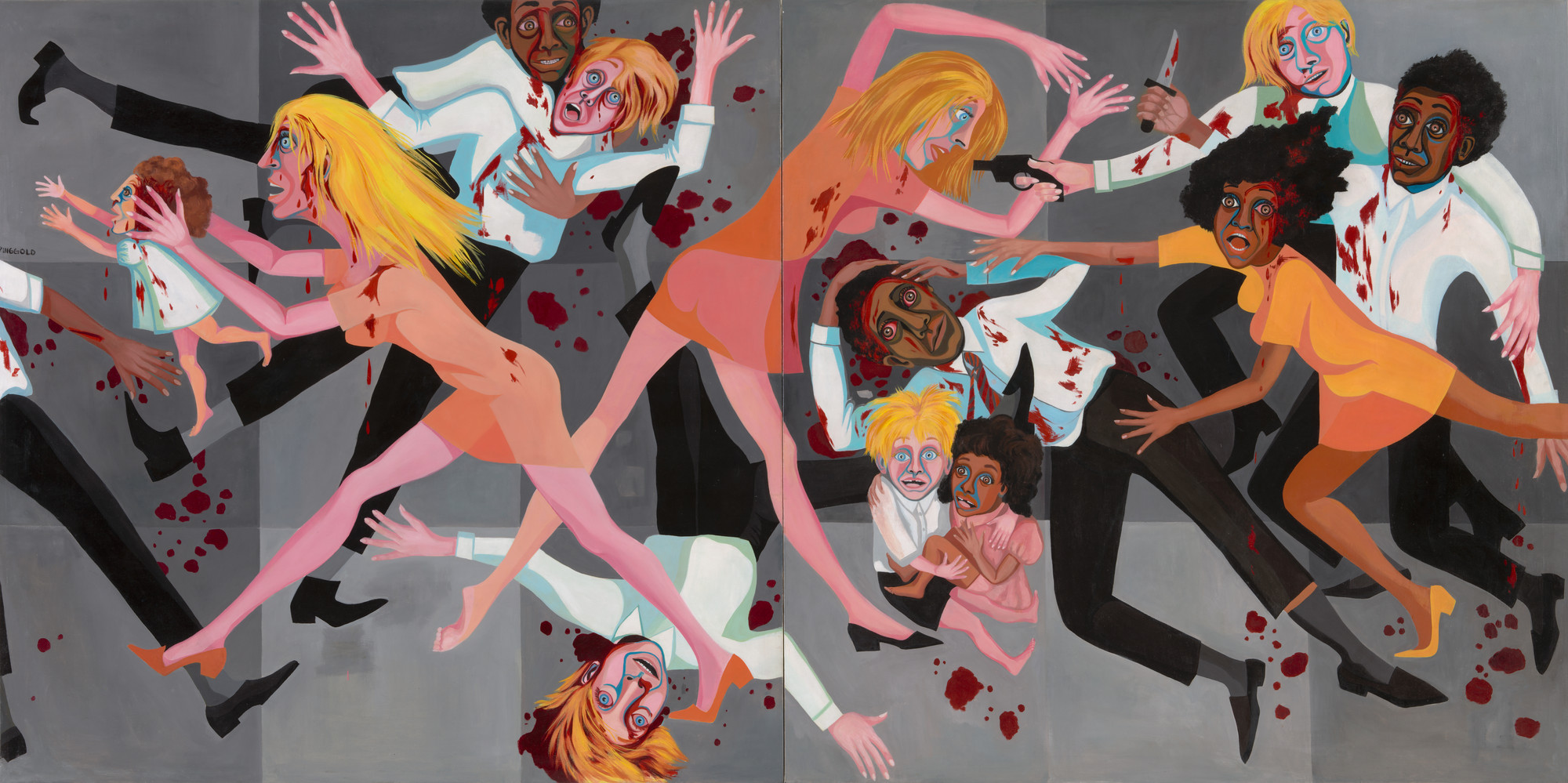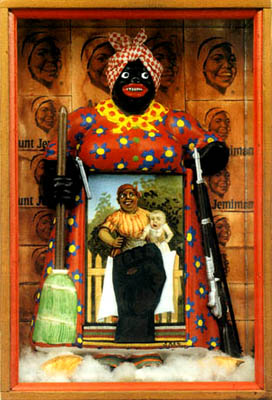.jpeg?1375522125) |
Gabriele Münter, Portrait of
Marianne von Werefkin, 1909.
A depiction of the color schemes
and simplification of abstraction. |
Movements such as modernism and postmodernism revolutionized the twentieth century, thanks to women artists that broke the norms of their time period and made a new pedestal for art. In the book, Women, Art, and Society by Whitney Chadwick, the author demonstrates the development of modernism and postmodernism. By analyzing the works of many great women artists, Chadwick explains how these new approaches that defined what modernism and postmodernism is shaped the twentieth century and the future of art. Methods such as simplification and color schemes, and movements such as abstraction and surrealism set forth a new standard of
mastery in the world of art that had a ripple effect on the culture of the time. Women artists shaped the way art is approached during the eras of modernism and postmodernism with techniques that are still resonating in today’s generation.
 |
Alexandra Exter, Composition, 1914.
As referenced in the text, the bold
geometric shapes that defines
abstraction. |
Modernism was the new era of art, during the turn of the twentieth century, when women artists in Europe took art that was traditional and “outdated,” and turned it into a new form of art that was new and unique. Techniques such as abstraction, dada, and surrealism illustrated how they influenced the culture of the twentieth century. Abstraction was first developed in the beginning of the twentieth century and it was viewed as a new form of art that symbolized the modern culture and, most importantly, it’s unorthodox techniques that had never been seen before. Artists such as Gabriele Münter was very influential in shaping the art of abstraction and building the foundation for other artists to follow. Münter expanded abstraction by “reducing form to simplified color shapes bounded by dark contour lines…”( Chadwick 255). By looking at Münter’s glass painting, Portrait of Marianne von Werefkin 1909, it’s clearly demonstrated how the visual representation of the subject is uncomplicated. The black outlines around the subject flattens the image, while the colors are represented in huge blocks that make the image look clear and straightforward. Another great example of the visual portrayal of abstraction was Composition by
 |
Sophie Taeuber, Vertical Horizontal
Composition, c. 1926-18. This
piece represents the techniques
of dada like the representation
of the textiles joining together
to create a masterpiece. |
Alexandra Exter, 1914. The mixing of colors and the geometric shapes breaking the plane, while at the same time, showing folk symbols vividly showed the techniques women artists used in making abstraction pieces of art. In addition, abstraction played a vital role in
fashion, “which translated the principles of abstraction to, and defined modernity for, a broad public” (Chadwick 262). Not only was abstraction viewed in paintings, it was also translated onto clothes where women who were viewed as the symbol for modernity were seen wearing clothing with these bold abstraction patterns on them. Dada, on the other hand, was another form of movement during the era of modernism. Similar to abstraction, dada utilized an array of colors in its technique; however, dada mostly, incorporated textile designs. In Sophie Taeuber’s, Vertical Horizontal Composition, c. 1916-18, the different shades of colors used and the way textiles are joined together explains why many women wore these patterns that were viewed as fashionable. Dada was even used by architects because of its elegant geometric designs. It was because of the liberal and feminist attitudes of women artists that made Dada so popular during the twentieth century with some of its techniques still used today. Surrealism was another popular technique during modernism that altered reality and gave the spectator a visually surreal experience. Analyzing I Wanted to be a Bird, 1938, by Leonora Carrington, really depicted the unique representation of the irrationality of surrealism. Looking at the image, the spectator is taken deep into the artist’s unconscious mind where he or she gets a sense of the emotions and creativity that the artist
 |
Leonora Carrington, I wanted to
be a Bird, 1938. An illustration
of the out of reality experience
of surrealism. |
experienced.
Postmodernism arose in the mid twentieth century, and it disputed major trends that embodied modernism. Many women artists took some of the techniques that symbolized modernism such as the simplification techniques of abstraction and built on it to create the contemporary art that is seen today. One of the major themes of postmodern art was its use of collages, symbolism, and simplification to demonstrate the issues going on in society such as discrimination and sexism. Artists such Faith Ringgold was an instrumental tool in showing the world the mistreatments of African Americans that were not talked about at the time through her artwork. In 1967, “Ringgold exhibited Die, a twelve-foot wide mural of a street riot painted in a simplified representation style…” (Chadwick 342). Looking at Die, the techniques of abstraction can be shown with the simplified depiction of the subjects in the painting, and the geometric squares that brought the image together. However, just as this piece of art depicted themes of modernism, it was still very much different. Through Die, Ringgold was able to illustrate the violence and cruel treatments that African Americans faced on the street as part of their everyday
 |
Faith Ringgold, Die, 1967. A great piece
showing the violence and discrimination of
African Americans during the civil rights movement. |
lives during the civil rights movement. Moreover, Ringgold’s piece could still be used today to connect with the mistreatments of African Americans that still goes on on a daily basis. Another major artist that contributed to the unspoken mistreatments of African Americans was Betye Saar. In her masterpiece, The Liberation of Aunt Jemima, 1972, Saar illustrated the symbol of the black servant who took care of the white baby as seen in the center of the image. Jemima was seen holding a rifle and a grenade alongside a broom to grab the spectator’s attention; combined with the collage of Jemima in the background, Saar was screaming at society to liberate the stereotype of the black woman. Almost fifty years later, and people could still connect with Saar’s piece; Aunt Jemima’s picture is still depicted on pancake boxes and maple syrups in supermarkets, clearly demonstrating that African American women are still associated with being maids. Addressing political issues, and protesting against current world problems is part of what defines postmodernism; the ability to communicate with society in issues that are not talked about.
 |
Betye Saar, The Liberation of Aunt
Jemima, 1972. As mentioned in the text,
the symbolism of Saar, illustrating
the stereotypes of African American women. |
Art in the twentieth century was influenced greatly by modernism and postmodernism with styles and techniques that are still incorporated today. Because of the influences of artists such as Faith Ringgold, Gabriele Münter, and hundreds of other great artists, none of the developments of modernism and postmodernism would have been possible. These women built the foundation for upcoming generations that artists are still building on today. It’s easy to say that the rise of modernism and postmodernism shaped the twentieth century and pushed the boundaries of what art is.
--Peter Shafeek
Literature Cited:
- Chadwick, Whitney. Women, Art, and Society. Langara College, 2016.
.jpeg?1375522125)





No comments:
Post a Comment